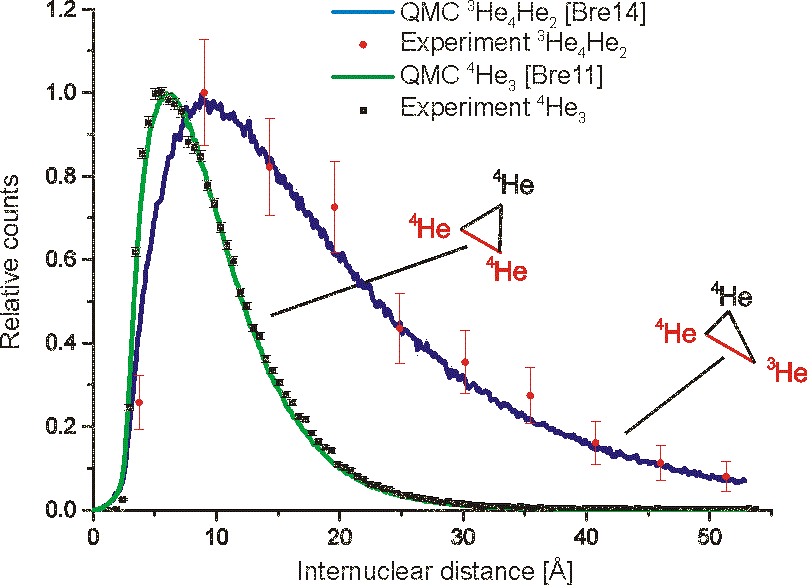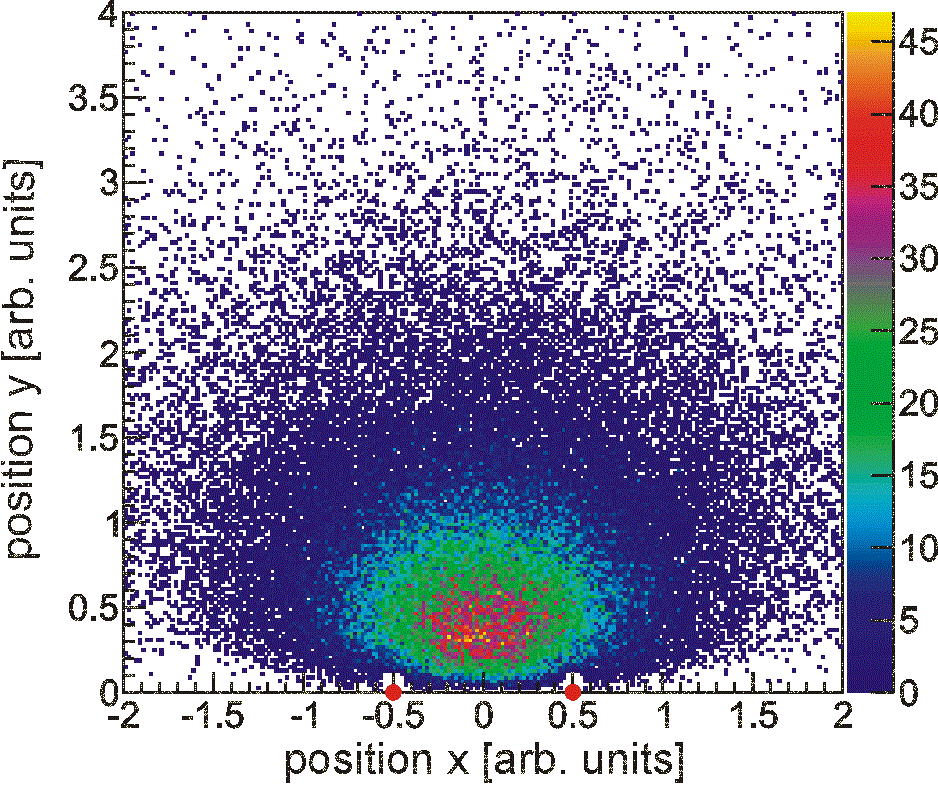Imaging the structure of the trimer systems 4He3 and 3He4He2
|
We investigate the structure of the weakly bound trimer systems 4He3 and 3He4He2. To do so, small helium clusters are produced in a supersonic gas expansion through a 5 μm diameter nozzle which is cooled down to a temperature of 12 K. In the case of 4He3 only about 3-5 % of the gasjet consist of the desired trimer, for 3He4He2 this fraction is even smaller with around 0.1 %. To seperate the trimers from the monomers and other clusters a transmission diffractiongrating with a period of 100 nm was used. As all particles of the jet travel with almost the same velocity, the helium clusters have a different deBroglie wavelength according to their mass. This leads to constructive interferences under different deflection angles for every cluster. Via overlapping the focus of the Ti:Sa Laser with the first order diffraction maximum of the trimers, a jet consisting solely of trimers can be investigated.
 Figure 1: Helium is expanded at 12 K at a driving pressure of 3 bar through a 5 μm nozzle to produce clusters. These are seperated by a 100 nm transmission diffraction grating. Behind the grating the first-order diffraction of the trimers is displayed in blue, the dimers in green. First-order monomers and the zero-order diffracted jet are shown in grey and illustrated on the screen in green. Dimers and trimers are not displayed on the screen because of their low intensity. Mass-selected clusters get ionized in a ~20 x 20 x 200 μm3 laser focus. Fragments are guided on a position and time-sensitive detector by a homogeneous electric field.
In the inner region of the laser focus single ionization is saturated, resulting in triply ionized trimers. In the outer region, however, the ionization probalility is not unity, and thus also events with two ionized and one neutral helium can be found. As the momentum of the neutral atom obtained in the fragmentation of the trimer can be neglected, those events can be used to obtain the distribution of internuclear distances of the atoms. The kinetic energy the ions gain in the Coulomb explosion can, in a good approximation, be transferred into a seperation before ionization by refelction approximation (R = 1 / KER).
 Figure 2: A comparison of the experimentally obtained internuclear distances of 4He3 and 3He4He2 with QMC calculations of Bressanini et al. ([Bre11]: Bressanini, Morosi, J. Phys. Chem. A 115, 10880 (2011), [Bre14]: Bressanini, J. Phys. Chem A 118, 6521 (2014)).
The distribution of internuclear distances demonstrates the extreme delocalization of a single molecular state. While covalent molecules have internuclear seperations of about 1 Å, the distribution of the pure 4He3 trimer stretches from a few Å to values of more than 30 Å. Compared to the He-He interaction potential thes values are classically forbidden. The potential has its minimium at ~3 Å and at about 10 Å the binding energy is higher than the potential depth, marking the classical turning point. Larger internuclear seperations can only be explained by quantum mechanical tunneling into the potential. As the tunneling probability depends on the mass of a particle, the distance of the 3He to the 4He atoms is even bigger. The distribution peaks at about 10 Å and stretches out further than 50 Å.
In addition to their huge size, another unique feature of small Helium clusters is their geometrical structure. While theoretical calculations of the binding energy of helium trimers are in good agreement, there was a long dispute concerning the shape of the system. While some publications proposed an equilateral triangle as the main shape, others predicted also linear configurations. To solve this dispute only the events originating in the center of the laser focus, in which the trimers get triply ionized, are considered. By solving Newton's equation of motion the particle momenta of these events are transferred into configurations in position space. In a first step these configurations are displayed as corner angles of the trimers.  Figure 3: A comparison of the experimentally obtained corner angles of 4He3 and 3He4He2 with variaous theoretical calculations ([Bre11]: Bressanini, Morosi, J. Phys. Chem. A 115, 10880 (2011), [Pao03]: Di Paola et al., Clooect. Czech. Chem. Comm. 68, 6936 (2003), [RaKr90]: Rama Krishna, Whaley, J. Chem. Phys. 93, 6738 (1990), [Gonz99]: Gonzalez-Lezana et al., PRL 82, 1648 (1999), [Bre14]: Bressanini, J. Phys. Chem A 118, 6521 (2014)).
In this representation a stiff equilateratal van-der-Waals molecule, like Ne3, would show a narrow peak at 60°, a linear molecule would have maxima at 0° and 180°. The distribution obtained from helium doesn't exhibit a narrow peak, but has entries starting from 0° and ending at 180°. The corner angles of 4He3 show a broad maximum at about 30°. In the case of 3He4He2 two distinguishable corner angles can be looked at, the one at the 3He and the two at 4He. It is clearly visible that the angle at the 3He peaks at lower values (about 15°), while the angles at the 4He peaks at ~40°. This must lead to an isosclele triangular configuration, a T-shaped molecule.
To get an even more intuitive picture of the geometry of 4He3 a two dimensional histogram should be helpful. A representation is chosen, in which two of the three indistinguishable particles are located at fixed positioins (red dots) and the density distribution of the third one is displayed in reference to them.  Figure 4: Density distribution of the third particle in the case where the first two are fixed at the position of the red dots. The gray cross marks the position of a hypothetical equilateral triangle.
In this histogram it is clearly visible that 4He3 has no fixed shape, the distribution of the third particle is highly diffuse. Almost linear configurations as well as equilateral ones are present in the data. This lack of rigid structure shows the unique charakter of helium trimers. They are spread over huge internuclear distances and have no clear geometrical structure. In the case of 3He4He2 a light tendancy towards an isoscele geometry can be seen. This preference of a geometrical shape is completely absent in 4He3.
More details can be found here: Imaging the structure of the trimer systems 4He3 and 3He4He2 J. Voigtsberger, S. Zeller, J. Becht, N. Neumann, F. Sturm, H.-K. Kim, M. Waitz, F. Trinter, M. Kunitski, A. Kalinin, J. Wu, W. Schöllkopf, D. Bressanini, A. Czasch, J.B. Williams, K. Ullmann-Pfleger, L. Ph H. Schmidt, M.S. Schöffler, R.E. Grisenti, T. Jahnke & R. Dörner Nature Communications 5, 5765 (2014) DOI: 10.1038/ncomms6765 An author's version of the publication can be found here |